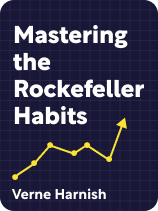

This article is an excerpt from the Shortform book guide to "Mastering the Rockefeller Habits" by Verne Harnish. Shortform has the world's best summaries and analyses of books you should be reading.
Like this article? Sign up for a free trial here.
What makes the difference between teams that consistently achieve their targets and those that fall short? How can you transform dry business metrics into engaging goals that motivate your entire team?
Setting and tracking goal metrics is essential for business success, but the approach matters just as much as the numbers themselves. From creating quarterly themes to maintaining focused visual scoreboards, there are proven strategies to keep teams unified and motivated toward common objectives.
Read on to discover how combining measurable targets with fun, engaging themes can transform your team’s performance and create a more energized workplace culture.
Goal Metrics
In Mastering the Rockefeller Habits, Verne Harnish recommends tracking goal metrics that measure the company’s short-term progress toward long-term goals. (Harnish calls these “Critical Numbers.”) Every year, decide on a new quantifiable goal metric that reflects significant progress toward your BHAG. Likewise, every quarter, set a smaller goal metric that marks significant progress toward the year’s goal metric. This ensures that everyone in the company is always unified in their top priorities.
For example, if a healthy soft drink company is trying to drive Coca-Cola out of business, their goal metric for one year might be to sell 150% more units than the previous year, and one of their quarterly goal metrics leading to this goal could be to invest in supply chain infrastructure to lower manufacturing cost by 30% (allowing them to lower the retail price and sell more units).
(Shortform note: On the other hand, in It Doesn’t Have to Be Crazy at Work, Jason Fried and David Heinemeier Hansson explain how they intentionally run their company 37signals (formerly Basecamp) without setting any quantitative annual or quarterly targets. They argue that such targets put unnecessary stress on employees and demoralize them by pressuring them to always do better. Instead, Fried and Hansson keep their company aligned by directing them toward the same stable, qualitative goals year after year, such as delivering a high-quality product.)
Create Fun Quarterly Themes
In addition to setting a quarterly goal metric, Harnish recommends creating an exciting theme for every quarter that drives home the Core Values behind your quarterly target—and makes achieving it more fun. Then, when your team hits their target, give them a reward that fits the theme. The reason quarterly rewards are enticing isn’t because the reward itself is practical or valuable. Rather, they allow the team to look forward to the satisfaction of celebrating their victories.
For example, if our soft drink company is trying to streamline their supply chain this quarter, their theme could be “Pass the Ball!” with soccer-themed posters in which different players represent stages of the supply chain. This soccer imagery could also reinforce the Core Values of teamwork and camaraderie. At the end of the quarter, the team could be rewarded with a new foosball table in the break room and a celebratory foosball tournament.
(Shortform note: Daniel H. Pink argues in Drive that offering specific rewards for goals like quarterly targets will decrease workers’ intrinsic sense of motivation. If an external reward makes people feel like they’re obligated to do a task rather than choosing to do it themselves, they’ll feel less motivated. That said, Pink notes that intangible rewards like positive feedback can increase intrinsic motivation. This is potentially another reason why the reward you offer should be a party or celebration rather than something practical or materially valuable.)
| The Benefits of Fun at Work In The Power of Fun, Catherine Price offers an explanation as to why setting a fun theme for your workers may be worthwhile. When people have “True Fun,” they feel more energized, less stressed, and do more creative work. True Fun is more complex than mere pleasure. It has three components: playfulness, which is activity without a higher purpose; connection with others; and flow, or total absorption in the task at hand. Quarterly themes incorporate all three elements of True Fun. There’s no practical reason you have to weave Core Values and quarterly targets into a soccer theme—but doing it anyway adds an element of playfulness to the workplace. Collaborative work naturally fosters connections between coworkers. And the theme provides a clear goal, which is one of the necessary conditions for workers to get into flow. |
Keep Your Goal Metrics Focused & Visible
Harnish recommends restricting these goal metrics to one area of improvement at a time rather than trying to improve every aspect of your business at once. Organizations make progress much more quickly when they focus all their efforts on a narrow goal.
(Shortform note: In The One Thing, Gary Keller explains that focusing on a single narrow goal yields the most progress because accomplishing one carefully chosen goal often triggers increasing returns. For example, if you focus your business on aggressive direct sales techniques for a quarter, you can reinvest the extra revenue into hiring new staff so you can get more work done, more quickly.)
Additionally, writes Harnish, display these metrics prominently, with large visuals, in a communal space. Employees are more engaged when they can clearly see the effects of their work.
(Shortform note: In The 4 Disciplines of Execution Chris McChesney, Jim Huling, and Sean Covey argue that this kind of scoreboard isn’t just helpful because it helps employees see the effects of their work. Rather, it also conveys to employees whether they’re currently winning or losing—that is, if they’re on track to meet their targets. The desire to win games is a powerful source of motivation, and a scoreboard is the best way to turn a team’s work into a game.)
Exercise: Use Goal Metrics to Drive Short-Term Results
Organizing a group to achieve any meaningful results requires unified short-term focus, which in turn requires everyone to aim at the same clear goal metric. Practice setting a goal metric like this to create alignment across an entire company or concentrate the efforts of a single team.
- What is one major short-term goal you want your team or organization to achieve? How does this goal help the organization make progress toward its grand, long-term purpose? (For example, perhaps you run a hotel and want to make guests more satisfied with their service. This would help your parent company achieve their vision of providing luxurious-feeling accommodations to travelers on a budget.)
- What goal metric can you use to direct and measure your team or organization’s progress toward this goal? Make sure this metric is quantifiable and narrowly focused. Why should this metric be your team’s top priority? (For example, your hotel could adopt the goal metric of sending someone to respond to guest requests in less than 10 minutes, 100% of the time. You may set this goal metric as a top priority because you notice that the least satisfied customers are people whose requests were ignored for long periods.)
- Brainstorm a fun theme for the time you’ll spend pursuing this goal metric. What Core Values or purpose are you trying to reinforce with this theme? What thematic reward could you give the team after they achieve this goal? (For example, you could make the theme for this quarter “Emergency Responders” and decorate your workspace with pictures of ambulances and other medical imagery. This could reinforce your Core Value that employees should treat customer satisfaction as a matter of life or death. As a reward, you could throw your team a fun hospital-themed party.)

———End of Preview———
Like what you just read? Read the rest of the world's best book summary and analysis of Verne Harnish's "Mastering the Rockefeller Habits" at Shortform.
Here's what you'll find in our full Mastering the Rockefeller Habits summary:
- What an oil tycoon can teach you about business
- How knowing your business’s unique value is key to beating the competition
- Why you should create fun themes for your quarterly goals






